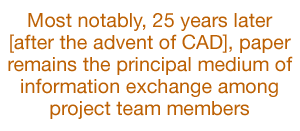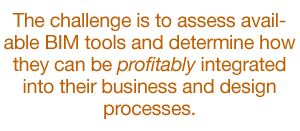
Faith-based BIM
Since personal computer technology first became widely available in the early 1980s, followed shortly thereafter by software applications for the building design and construction industry, the real capabilities of that technology have rarely kept pace with the hyperbole that quickly grew around it. At times, the hype has evolved into a belief system bearing little or no relationship to the daily reality of design and construction in architecture, engineering, and construction firms. Early enthusiasts of computer-aided design (CAD) technology may recall discussions or claims related to the “multiplier factor,” in which the value of this or that CAD application was ostensibly measured by whether using it was two, three, or four times faster than manual drafting. As the difficulties of harnessing CAD technology became evident, and the apparent lack of any multiplier benefit became evident, the “multiplier factor” and many other claims related to increased productivity and business process reform were quietly excised from AEC technologists’ vocabulary.
Today, similarly, optimistic claims are being made for building information modeling (BIM) technology. The common understanding of BIM is that all of the information related to a single building facility can be contained in a single, electronic building model that is available to anyone involved with the design, construction, management, and operation of that facility throughout its useful life. The availability of this information in a single, comprehensive, electronic database will ostensibly revolutionize business processes for everyone involved, with the result that buildings will be designed, constructed, and operated far more efficiently than is now possible. Using currently available technology, is it possible to achieve this vision? Yes. But is it possible for players in the industry—owners, designers, builders—to implement this comprehensive vision in their businesses today? In a word, no. BIM technology simply has not yet matured, despite the The greatest danger to the industry is that the growing BIM belief system will raise expectations beyond the ability of the technology to meet them, and that the inevitable resulting disillusionment will cause most players in the industry to ignore truly useful, revolutionary technologies when they finally do become available. This happened with many powerful CAD technologies that were never widely adopted despite their genuine usefulness. For AIA members, as for others in the AEC industry, the challenge
is to assess available BIM tools and determine how they can be profitably
integrated into business and design processes. Despite the fact that
BIM, as a comprehensive concept, remains more of a vision than a
reality, BIM tools are available today to realize at least part of
the vision, and in the process advance the art and science of building
design and construction for the entire industry. Over the next 15
months, AIArchitect will examine
how real firms—in architecture, engineering, construction,
and building management—are using BIM technologies that are
commercially available today to streamline their business processes,
improve team collaboration, shorten cycle time, improve service delivery,
and, in the end, improve the quality of service that they provide
to their clients. (If you would like your firm to be considered for
one of these case studies, contact the author at mtardif@aiadc.com.) |
||
Copyright 2006 The American Institute of Architects. All rights reserved. Home Page |
||
news headlines
practice
business
design
recent related
› Will BIM Be the Death of Design?
› BIM Evokes Revolutionary Changes to Architecture Practice at Ayers/Saint/Gross
› For BIM’s Sake
Michael Tardif, Assoc. AIA, Hon. SDA, is a freelance writer and editor in Bethesda, Md., and former director of the AIA Center for Technology and Practice Management.

 There have been incremental improvements, to be sure, and some AEC firms have succeeded in exploiting CAD technology better than others, but the fundamental processes of building design and construction remain largely unchanged. Most notably, 25 years later, paper remains the principal medium of information exchange among project team members—architects, engineers, contractors, subcontractors, building officials, and owners—and there is little evidence that this overwhelmingly common practice will change any time soon.
There have been incremental improvements, to be sure, and some AEC firms have succeeded in exploiting CAD technology better than others, but the fundamental processes of building design and construction remain largely unchanged. Most notably, 25 years later, paper remains the principal medium of information exchange among project team members—architects, engineers, contractors, subcontractors, building officials, and owners—and there is little evidence that this overwhelmingly common practice will change any time soon. fact that nearly all of the discussion of the subject is in the present tense.
fact that nearly all of the discussion of the subject is in the present tense.